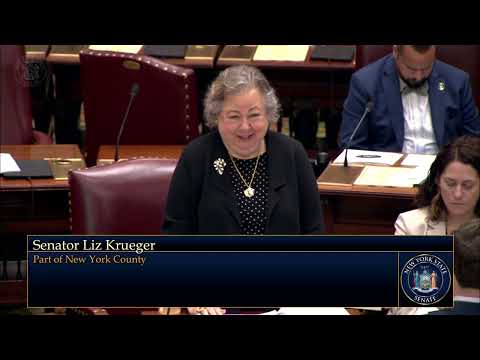
Testimony Before The New York City Board Of Elections Regarding The Selection Of Voting Machines For New York City Elections On November 21, 2006
Liz Krueger
July 15, 2010
Good evening, I am State Senator Liz Krueger, representing the 26th Senate District in Manhattan. I am here today to urge the New York City Board of Elections to select a Precinct Based Optical Scanning (PBOS) voting system for conducting future elections in the City. Fair elections are the centerpiece of our democracy, and in order to protect that democracy we must adopt the voting system that is the most reliable, verifiable, and easy for the voter and poll worker to understand. As a paper ballot based system, PBOS meets these standards, and is clearly preferable to computerized Direct Recording Electronic (DRE) systems, which require voters to trust the software, make verification difficult even with a voter-verified paper trail, and are more complicated for both voters and election workers to use.
The recent 2006 election has just confirmed the continuing problems with DREs. Once again, the results of a race in Florida are being contested, this time because one county had more that 18,000 ballots where no votes were recorded in the Congressional race, compared to less than 2,000 under-votes for every other county. Since Florida has no requirement for a voter-verified paper trail, there is no way to know whether these results are due to machine error, voter error, or simply an unusually large number of voters choosing not to vote in that race. There were literally hundreds of other reports of serious problems with DRE machines reported across the country, including vote-switching, power failures, broken machines, and falsely recorded tallies. These problems just confirm the results of numerous studies into DRE systems which have indicated they have a higher rate of spoiled or unmarked ballots than PBOS systems, that they are easier to sabotage, and that they can be hacked to alter the voting results recorded by these machines.
New York State law does require a voter-verified paper trail for any new voting system, which certainly increases the ability to ensure that election results are valid. However, even with a voter-verified paper trail, DREs do not perform as well as paper based PBOS systems in terms of verification. The mechanism for verifying the vote in a PBOS system is the actual paper ballot cast by the voter, which is available for counting later if there are any discrepancies with the optical scanner tallies. With DRE machines, the verification method is a printed copy of the voter’s record. In practice this mechanism can fail in a number of ways. First, printers can malfunction, thus eliminating the record altogether. Second, if the voter does not actually check to make sure the printed record records their vote as they entered it on the machine, the record will be inaccurate.
Finally, the quality of this record has been compromised in the past by poor printer quality. In an attempted recount of Ohio precincts from 2004 using DREs with a voter-verified paper trail, fully ten percent of the printed records were found to be unreadable. Thus while it is certainly better to have a DRE with a paper trail than one without, this method of verification remains inferior to the actual marked ballots that are available with a PBOS system.
In addition to these technical problems, I am also concerned that DREs create significant usability issues for both voters and poll-workers. Voting systems must be user friendly, and not intimidate voters. I have heard from numerous constituents who are not familiar with computers and doubt their ability to use DRE technology. These voters could effectively be disenfranchised if such technology is adopted. I also have serious concerns about the ability of poll workers to address the technical problems that often occur with DREs. Again, reports of election problems throughout the country in 2004 and 2006 often involve the inability of the poll workers in particular jurisdictions to resolve problems with machines, or to adequately instruct voters as to the operation of these machines. With something as important as voting, we should recognize that a simple, easy-to-understand, user friendly system is preferable to a complex one.
A final issue with DREs that must be taken into account is the fact that, because there have been so many well reported problems with them, many voters do not believe this technology can be trusted. A CNN poll conducted in October of 2006 found that 66 percent of respondents felt it was somewhat or very likely that a significant number of votes cast on DREs would be inaccurately recorded due to the intentional actions of hackers or others attempting to manipulate the vote. This is a critical problem for our democracy. If people do not believe their vote is going to be accurately recorded, they are less likely to participate in the political process. New York State should not be adopting a voting system viewed as lacking legitimacy in the eyes of the public.
Fortunately, three of the vendors who want to provide voting systems to New York City are offering PBOS systems with ballot marking devices for people with disabilities. New York City should only consider these systems. Precinct-Based Optical Scan systems have numerous advantages over DREs:
- They are more reliable – a recent study by the Brennan Center found that PBOS systems had significantly lower voter error rates than full faced DREs.
- Votes are easier to verify with PBOS systems, because the actual paper ballot can be used to verify the vote.
- PBOS systems are also less technically complex, making them easier to use for both voters and poll workers.
- Finally, while cost should not be a determining factor for something as important as our election system, experience has shown that PBOS systems cost significantly less, particularly with regard to maintenance and replacement costs, than DRE systems.
For these reasons, I urge the New York State Board of Elections to choose one of the Precinct Based Optical Scanning systems for future New York City elections. Thank you for the opportunity to testify this evening.
Share this Article or Press Release
Newsroom
Go to NewsroomTREES Act Passes Both Houses Of The Legislature
May 16, 2024



